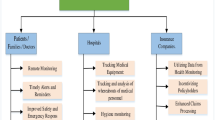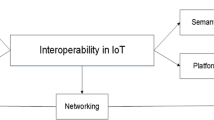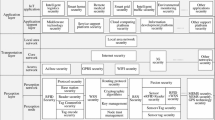Abstract
With the recent advances in ubiquitous communications and the growing demand for low-power wireless technology, smart IoT device (SID) to access various Internet of Things (IoT) resources through Internet at any time and place alternately. There are some new requirements for integration IoT servers in which each one is individually gathering its local resources in Internet, which cooperatively supports SID to get some flexibility or temporary contract(s) and privileges in order to access their corresponding desired service(s) in a group of collaboration IoT servers. However, traditional access control schemes designed for a single server are not sufficient to handle such applications across multiple collaboration IoT servers to get rich services in IoT environments. It does not take into account both security and efficiency of IoT servers, which securely share their resources. Therefore, the collaboration IoT-based RBAC (Role-based Access Control) with trust evaluation (TE) algorithm model to reducing internal security threats in intra-server and inter server for the massive IoT integrated application is proposed in this paper. Finally, the three trust evaluation algorithms including a local trust evaluation algorithm, a virtual trust evaluation algorithm and a cooperative trust evaluation algorithm in the proposed collaboration IoT-based RBAC model, which are designed and presented for reducing internal security threats in collaborative IoT servers.




Similar content being viewed by others
References
Chen H-C (2017) A cooperative RBAC-based IoTs server with hierarchical trust evaluation mechanism. Proceedings of IoTaaS 2017 – 3rd EAI International Conference on IoT as a Service, Sept. 20–22, 2017, Taichung, Taiwan
Chen H-C, Chang C-H, Leu F-Y (2017) Implement of agent with role-based hierarchy access control for secure grouping IoTs. The14th IEEE Annual Consumer Communications & Networking Conference (CCNC), pp120–125, Las Vegas, USA, 8–11 Jan. 2017
Zhong S, Zhang L, Chen H-C, Zhao H, Guo L (2017) Study of the patterns of automatic car washing in the era of internet of things. The 31st IEEE International Conference on Advanced Information Networking and Applications (AINA-2017), pp. 82–86, Tamkang University, Taipei, Taiwan, Mar 27–29, 2017
5G Americas (2017) LTE progress leading to the 5G massive internet of things. 3GPP enhancements up to release 14 [On-line]http://www.5gamericas.org/files/8415/1250/0673/LTE_Progress_Leading_to_the_5G_Massive_Internet_of_Things_Final_12.5.pdf,Retrieved on Mar. 08, 2018
Linko S, Garsbo C, Shi L (2017) Massive IoT: different technologies for different needs-wide area mesh networks can meet the requirements for large-scale IoT. Northstream White Paper, Wirepas & Northstream, Jun. 29, 2017. [Online] https://wirepas.com/download/
Patel M, Shangkuan J, Thomas C (2017) What’s new with the Internet of Things? McKinsey & Company. Retrieved from http://www.mckinsey.com/industries/semiconductors/our-insights/whats-new-with-the-internet-of-things
Cardoza C (2017) Solving the internet of things integration problem. SD Times, Jan. 25, 2017. [Online] https://sdtimes.com/developers/solving-internet-things-integration-problem/, Retrieved on Mar. 08, 2018
Malhan M, Filipovic S (2017) Network services for massive IoT. Ericsson [Online] https://www.ericsson.com/en/networks/offerings/cellular-iot/network-services-massive-iot, Retrieved on Mar. 08, 2018
Akl SG, Taylor PD (1983) Cryptographic solution to a problem of access control in a hierarchy. ACM Trans Comput Syst 1(3):239–248
Ferraiolo DF, Kuhn DR (1992) Role-based access controls. In: Proceedings of the 15th national computer security conference, pp 554–563, Oct 13–16, 1992
Sandhu RS, Coyne EJ, Feinstein HL, Youman CE (1996) Role-based access control models. Computer 29:38–47
Balamurugan B, Krishna PV (2015) Enhanced role-based access control for cloud security. Artificial intelligence and evolutionary algorithms in engineering systems. Adv Intell Syst Comput 324:837–852
Chen H-C (2015) A trusted user-to-role and role-to-key access control scheme. Soft Comput 1–13
Zyskind G, Nathan O (2015) Decentralizing privacy: using blockchain to protect personal data. Security and Privacy Workshops (SPW), 2015 IEEE CS Security and Privacy Workshops, pp 180–184
Yu Z, Yu T (2012) Mining trust relationships from online social networks. J Comput Sci Technol 27(3):492–505
Mishra D, Soni D (2014) A comprehensive overview on data mining: approaches and applications. Int J of Computer Science and Information Technologies 5(6):7814–7816
Chen H-C, Su H-K( 2014) A cooperative trust bit-map routing protocol using the GA algorithm for reducing the damages from the InTs in WANETs. J of Internet Services and Information Security 4(4):52–70
Chen H-C (2017) TCABRP: a trust-based cooperation authentication bit-map routing protocol against insider security threats in wireless ad hoc networks. IEEE Syst J 11(2):449–459
Trifa Z, Khemakhem M (2014) Sybil nodes as a mitigation strategy against Sybil attack. Procedia Computer Science 32:1135–1140
Chen H-C (2017) A negotiation-based cooperative RBAC scheme. Int J Web Grid Serv 13(1):94–111
Chen H-C, Violetta MA, Yang C-Y (2013) Contract RBAC in cloud computing. J Supercomput 66(2):1111–1131
Acknowledgements
This work was supported in part by Asia University, Taiwan, and China Medical University Hospital, China Medical University, Taiwan, under Grant ASIA-106-CMUH-04. This work was also supported in part by the Ministry of Science and Technology (MOST), Taiwan, Republic of China, under Grant MOST 106-2632-E-468-003.
Author information
Authors and Affiliations
Corresponding author
Rights and permissions
About this article
Cite this article
Chen, HC. Collaboration IoT-Based RBAC with Trust Evaluation Algorithm Model for Massive IoT Integrated Application. Mobile Netw Appl 24, 839–852 (2019). https://doi.org/10.1007/s11036-018-1085-0
Published:
Issue Date:
DOI: https://doi.org/10.1007/s11036-018-1085-0




